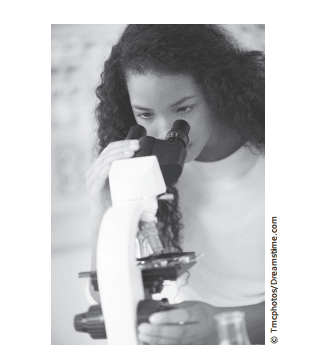Feel free to use or edit a copy
includes Teacher and Student dashboards
Track each student's skills and progress in your Mastery dashboards
With a free account, teachers can
- edit the questions
- save a copy for later
- start a class game
- automatically assign follow-up activities based on students’ scores
- assign as homework
- share a link with colleagues
- print as a bubble sheet
12 questions
Show answers
- Q1The picture shows a student using a microscope to study a prepared slide of a single-celled organism. A single-celled organism can be classified as a prokaryote based on the absence of —chromosomesa cell membranea nucleusribosomes30sB.4.A: Prokaryotic & Eukaryotic Cells
- Q2Some students used information they gathered from lab investigations to prepare a table. They entered the table in their lab notebooks. Which of these correctly identifies the two cells described in the table?Both Cell 1 and Cell 2 are eukaryoticCell 1 is prokaryotic, and Cell 2 is eukaryoticBoth Cell 1 and Cell 2 are prokaryoticCell 1 is eukaryotic, and Cell 2 is prokaryotic30sB.4.A: Prokaryotic & Eukaryotic Cells
- Q3Both euglena and cyanobacteria are photosynthetic unicellular organisms found in pond water. The feature that distinguishes euglena from cyanobacteria is the —ability to reproducepresence of ribosomesability to maintain homeostasispresence of a nuclear membrane30sB.4.A: Prokaryotic & Eukaryotic Cells
- Q4A student groups different types of cells as shown. Which table headings should the student use for the two groups?60sB.4.A: Prokaryotic & Eukaryotic Cells
- Q5Which structure can be found in both eukaryotic and prokaryotic cells?MitochondrionNucleusNucleic acidChloroplast60s
- Q6Which structure does not belong in a prokaryotic cell?CytoplasmPhospholipid bilayerDNANuclear membrane60s
- Q7Which of the following is a defining characteristic of a prokaryotic cell?The method of cellular respirationThe composition of the cell membraneThe method of movementAbsence of a membrane-bound nucleus60s
- Q8Scientists think eukaryotes may have evolved from an endosymbiotic relationship between prokaryotes of mitochondria and host parasitic cells. One piece of evidence that supports this endosymbiosis theory is that mitochondria have their own system of transcription and translation that more closely resembles protein synthesis in prokaryotes than eukaryotes. Upon evaluation of this information, which of the following statements is most likely true?Protein synthesis in the mitochondria is the result of bacterial cell infection.There was never a symbiotic relationship between prokaryotic cells and eukaryotic cells.At one time, mitochondria may have been primitive prokaryotic cells.Mitochondria do not have DNA and, therefore, do not produce mitochondrial RNA.60s
- Q9What evidence best supports the Endosymbiotic Theory which states that current cell organelles, like mitochondria and chloroplasts, were once prokaryotic cells consumed by other prokaryotic cells?Mitochondria and chloroplasts are both performing the same function.Mitochondria and chloroplasts can break away and live on their own without the host cell.Mitochondria and chloroplasts act as parasites inside the host cell.Mitochondria and chloroplasts have DNA coding different from the nuclear DNA.60s
- Q10Most viruses have the structural arrangement of —a capsid surrounding a nucleic acid sequencea cell wall surrounding the cell membraneflagella surrounding the cell membranea capsid shell made from lipids60s
- Q11The picture shows a 3-D model of a virus called a bacteriophage. Bacteriophages can infect bacteria such as E. coli. In what way are the bacteriophage and E. coli alike?They contain antibodies.They reproduce by mitosis.They have identical genomes.They lack membrane-bound organelles.60s
- Q12What is not a part of the cell theory?All cells come from pre-existing cellsCells are the basic unit of lifeThe first cell spontaneously appearedAll living things are made of cells60s

